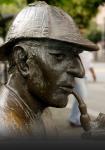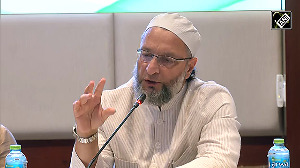Iran's new president was a member of the hard-line Islamic student group that seized of the US Embassy in Tehran in 1979, but he opposed the takeover - preferring instead to target the Soviet Embassy, friends and former hostage-takers said Thursday.
The former students who carried out the seizure and held the Americans for 444 days said Mahmoud Ahmadinejad had no role in taking the embassy or guarding the hostages.
Iran reformers out in the cold
In the turbulent early days of Iran's Islamic Revolution, Ahmadinejad was more concerned with putting down leftists and communists at universities than striking at Americans, they said. During the long standoff, he was writing and speaking against leftist students, they said.
Five former US hostages who saw the president-elect in photos or on television said they believe Ahmadinejad was one of the hostage-takers. One said he was interrogated by Ahmadinejad.
The White House said Thursday it was taking their allegations seriously.
The flap could add another layer of mistrust between the United States and the former Tehran mayor, who was elected president last week with the backing of some of the most hard-core members of Iran's Islamic regime.
Leaders of the Office of Strengthening Unity, the radical Islamic student group that carried out the November 4, 1979 takeover of the embassy, said Ahmadinejad was not among the hostage-takers.
``He was not part of us. He played no role in the seizure,'' Abbas Abdi, one of six leaders of the group, told The Associated Press.
Mohsen Mirdamadi, leader of the students who swept into the embassy, also said Ahmadinejad was not involved.
Abdi and Mirdamadi are now leading proponents of reform that would support democratic changes, and are at loggerheads with Ahmadinejad.
Mohammad Ali Sayed Nejad, a longtime friend of the president-elect, said he and Ahmadinejad - a student at Tehran's Science and Technical University at the time - were the only two members of the Office of Strengthening Unity who opposed taking the US Embassy.
``While the bulk of student leaders planned and took part in the seizure of the US Den of Spies (U.S. Embassy), we two were extremely worried about communist groups,'' Sayed Nejad said.
Ahmadinejad ``was a constant opponent'' of taking the US mission, he said.
He and Ahmadinejad instead wanted the students to seize the Soviet Embassy but the idea gained no support among the rest of the group.
Ahmadinejad told colleagues in a recent meeting he opposed targeting the American mission because it would bring international condemnation down on Iran.
``I believed that if we did that, the world would swallow us,'' he said, according to aide Meisan Rowhani, who was at the meeting.
Ahmadinejad dropped his opposition to the US Embassy takeover
The Office of Strengthening Unity was formed before the embassy takeover, and its main goal was to support Khomeini's bid to impose an Islamic government in the chaotic time after the removal of the US-backed Shah Mohammed Reza Pahlavi.
During that period, student supporters of communist parties were in an ideological fight with Islamic groups over the direction of the revolution. Ahmadinejad focused on opposing communism and Marxism, writing articles in student publications and making speeches against the threat of communism, Sayed Nejad said.
The embassy takeover galvanized the Islamic factions who were already gaining control of the revolution. The embassy became a focal point for Islamic supporters; hundreds of students, even those not directly involved in the holding of the hostages, had access to the embassy.
Former American hostages Chuck Scott, David Roeder, William J. Daugherty and Don A. Sharer told AP that after seeing Ahmadinejad on television, they were certain he was one of the hostage-takers. A fifth ex-hostage, Kevin Hermening, said he reached the same conclusion after looking at photos.
``I can absolutely guarantee you he was not only one of the hostage-takers, he was present at my personal interrogation,'' Roeder told AP in an interview from his home in Pinehurst, N.C., though he added, ``It's sort of more mannerisms.''
Daugherty and Sharer said they believe Ahmadinejad is shown in two AP photos taken a few days after the embassy was seized. One photo show a blindfolded American being led on either side by two bearded men. The two former hostages said one of the men resembles Ahmadinejad.
Abdi and several other former hostage-takers, however, were shown the same photos and said they did not believe the man was Ahmadinejad.
``I don't believe it's him,'' said Abdi. ``I don't think it even resembles him.''
Members of Ahmadinejad's office refused to look at the photos or comment on the allegations.
``The president-elect will have four years ahead with a lot work that needs to be done. We won't enter a media game,'' Kaveh Eshtehardi, an aide to the president-elect said when asked to look at the pictures. ``We won't heed such allegations.''
Guards prevented AP from entering Ahmadinejad's office to present the photos.
A picture on Ahmadinejad's campaign Web site shows the president-elect at college age. His features are softer than the man in the photo, his hair and mustache thinner and beard shorter.
Bijan Adibi, another former hostage-taker, also viewed the photos and didn't believe it was Ahmadinejad. He noted the man in the picture is about the same height as everyone else in it, including the American. Adibi said Ahmadinejad is a little shorter than him - and Adibi stands at about 5 feet 2 inches.
``Look at every picture of Ahmadinejad today and he is at least a head shorter. In this picture, this man is the height of the American,'' Adibi said. ``For many other reasons, I am certain that this picture is not Ahmadinejad.''





